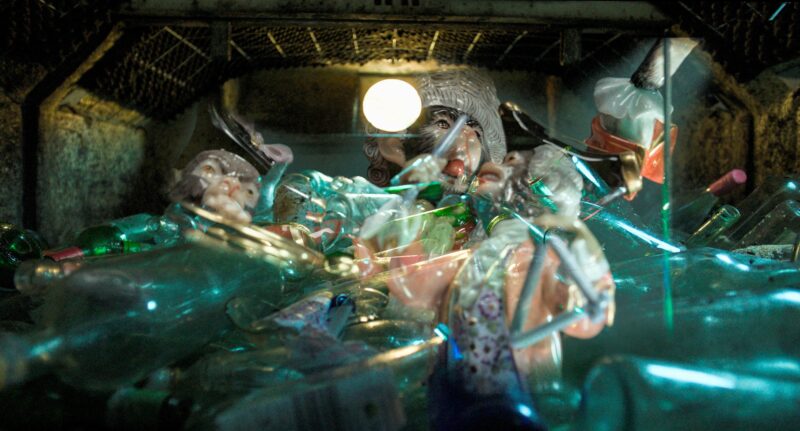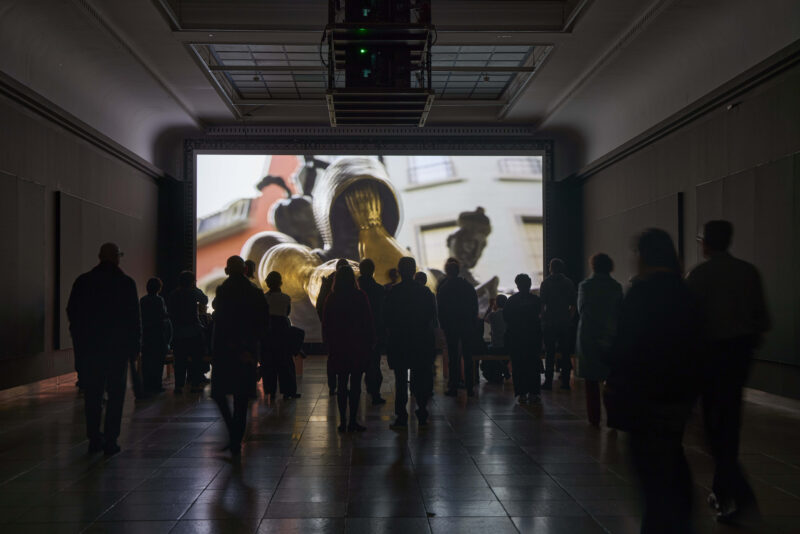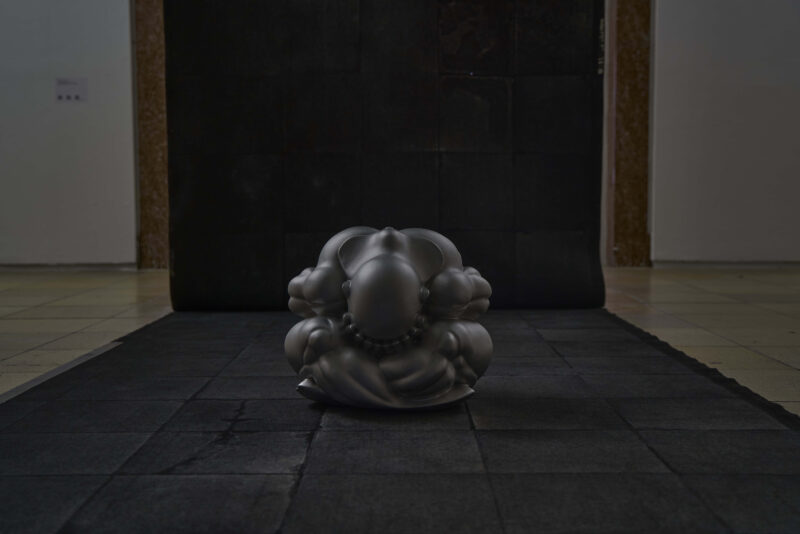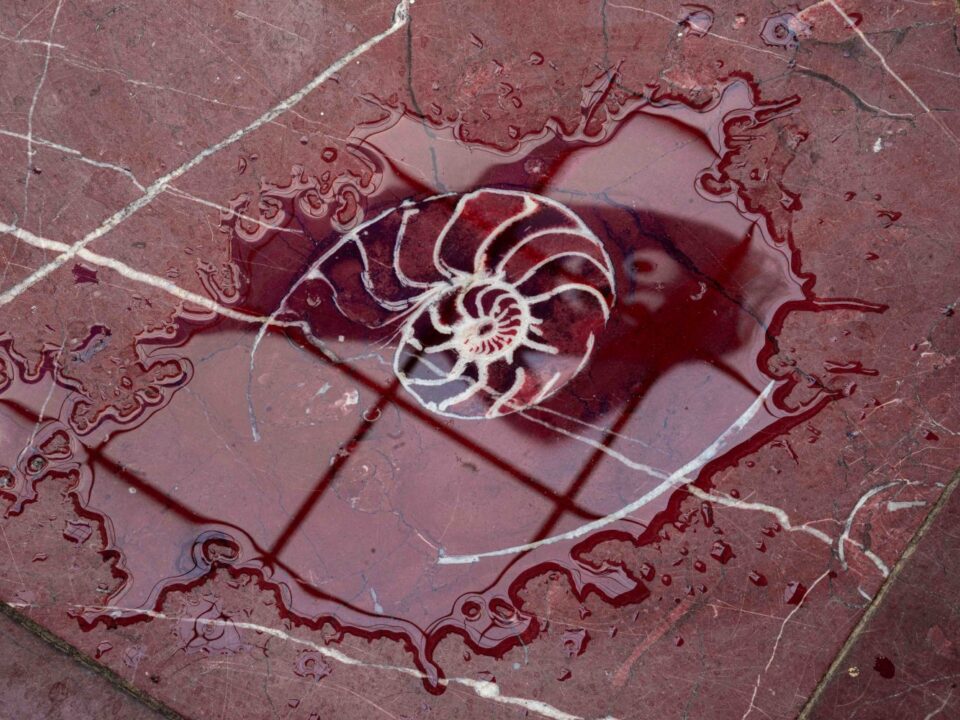Water permeates the new body of works in this solo presentation by Cyprien Gaillard (b. 1980, Paris). This essential yet often unseen force binds our reality: coursing through the air we breathe, shaping the contours of landscape, and wearing the fabric of our cities. Working at the intersection of human artefacts, urban geography, and psychology, Gaillard’s extraordinary cosmos gives new form to such phenomena as civilisational upheaval and geological time. Across photography, sculpture, film, video, collage, installation, and live performance, his work embraces a poetry of decay that rearranges history to shed new light on the present.
In “Wassermusik”, Gaillard attunes to water as an elemental force—passing through time and linking traces in collapsed histories. Through architectural interventions, film, sculpture, and archival materials, he modifies the Südgalerie with remnants such as 1930s exit signage, more recent furniture, a well-trodden basement carpet, revealing the strata of tenants who once inhabited the building. Among the most enduring non-human witnesses are the ammonite fossils on the marble floors, glimmering with splashes of water.

At the centre of the exhibition is Gaillard’s latest stereoscopic motion pictures Retinal Rivalry (2024), partially filmed in Munich and co-produced by Haus der Kunst. By harnessing cutting-edge technology to its full potential, Gaillard offers an expanded, sharpened and deeply affecting vision of the world around us. Seminal within his oeuvre, this landmark work redefines moving image as sculpture. It leads viewers on a journey through folded time and inaccessible urban surfaces: dumpsters and subterranean arteries, humid landscape, and views as seen through the eyes the Bavaria statue at Oktoberfest. In its sculptural and psychedelic space, the work disrupts conventional perception, dissolving a narrative to reveal pure vision.
Works purposefully created by the artist from two archives frame the exhibition: Haus der Kunst in Munich and Musée de l'Orangerie in Paris, both sites bearing scars from the Second World War. A selection of furniture (circa 1930–present day) from Haus der Kunst rests heavily in the room, recalling the negotiations of its past tenants over the building’s repurposing. Their now-empty chairs evoke the haunting presence of these entities, lingering in the space. Striking photographs document the water leakage at the Musée de l'Orangerie during the summer of 1944, when bombings caused ceilings to collapse: water creeping across surfaces, the peeling fabric revealing ghostly floral patterns, uncannily echoing Monet’s final Water Lilies painting in the artist-designed architecture. Through this assembly of materials, Gaillard stages a dialogue between natural forces and human constructs, rendering sites into living monuments that combine temporal visions beyond the here and now.
The new sculpture Absorbent Figure, made of aluminium and modelled on the small Weeping Buddha souvenirs—first appeared in Indonesia in the 1970s for tourists as craft objects rather than religious symbols. Its head is permanently sunk into its arms in an expression of profound grief. In its doubled meaning, it becomes a paradoxical witness to erosion, belief, and transmission across time.
This exhibition continues Haus der Kunst’s vision in reimagining the meaning of monuments that have lost their original purposes and meanings, and in exploring how public monuments can generate new significance and collective experience. Following solo exhibitions such as “Voices” by Philippe Parreno, “Mute” by Pan Daijing, and “Window of Tolerance” by Wang Shui, Gaillard’s new exhibition furthers Haus der Kunst’s experimental programme, integrating forefront technology, time-based media, and exploring liveness as a new form of exhibition-making and artistic practice.
This exhibition is made possible with the Supporting Friends of Artistic Director and Chief Curator.
Curated by Xue Tan with Lydia Antoniou and Laila Wu.


Upcoming events:
14.12.25
Guided tour on “Cyprien Gaillard. Wassermusik”
Sunday 4:00 PM – 4:30 PM
21.12.25
Guided tour on “Cyprien Gaillard. Wassermusik”
Sunday 4:00 PM – 4:30 PM
26.12.25
Open Haus in December — Free admission, priceless experience
Friday 4:00 PM – 10:00 PM
4.1.26
Guided tour on “Cyprien Gaillard. Wassermusik”
Sunday 4:00 PM – 4:30 PM
